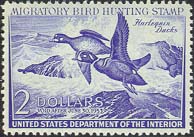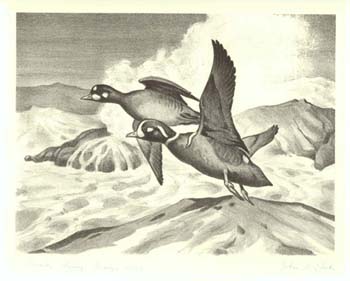

Back to RW19 Back to the Federal Index Home
A LITTLE HISTORY ON THE 19TH (1952-53) DUCK STAMP ARTIST


When John H. Dick was a small child in Islip, Long Island, New York, he started a hobby that he would carry into his later life. Unlike many wildlife artists, his first interest wasn't drawing, but rather aviculture. Even as a small child, he had a respectable collection of both American and foreign wild ducks, pheasants, quail and geese. He did do some drawing at the time but his collection was his major interest. He drew only for fun and not with any idea of becoming an artist.
Mr. Dick was born in Islip on May 12, 1919 (social security records show May 24). He left the area to serve in the Air Corps. In 1947, he went to live on the plantation which had once belonged to his mother. It was at this time that he began his first professional drawings of birds. At the time, he worked on commissions and as an illustrator for numerous magazine articles and books.
His photography had been the interest which took him throughout the world. He often deserted his plantation in the low coastal country of South Carolina to travel anywhere in the world where it was possible to photograph birds and animals. His travels took him to a wide variety of places, from the Galapagos Islands to the Palmer Peninsula of Antarctica. He also traveled to East Africa, India, Scotland, the Bahamas, Tierra del Fuego, and all over the United States.
If the animals he found abroad were not enough for him, there was always plenty of reference material for his paintings when he returned home. He kept may birds in aviaries and open pens at the plantation. He had about 40 species of ducks, including Baikal Teal, Laysan teal, Falcated Ducks, New Zealand Scaup, Mandarin ducks and five kinds of tree ducks. Some of the other permanent residents of his plantation are 18 species of geese and swans, pheasants, and peafowl. Undoubtedly some migratory guests also mingle with the year long residents. From all the varieties of ducks on his plantation, Mr. Dick chose the Harlequin Ducks for his Duck Stamp design because he considered them to be among the most attractive of all the sea ducks he had seen.
In addition to his Duck Stamp painting and his photographs, Mr. Dick also illustrated several books. Some of these books are The Bird Watchers of America edited by Olin S. Pettingill, McGray-Hill Book Company, 1966; Carolina Low Country Impressions by Alexander Sprunt, Devin-Adair Company, 1964; A gathering of Shore Birds by H.M. Hall, Bramhall House, 1959; Warblers of America by Sprunt and Criscom, Devin-Adair Company, 1957; Florida Bird Life by Sprunt, Coward-McCann, Inc.; and South Carolina Bird Life by Sprunt and Chamberlain, University of South Carolina Press, 1949.
Mr. Dick died on May 9, 1997.
-------------------------THE ART-------------------------
Harlequin Ducks was done in watercolor wash. A stone lithograph was hand pulled
using white Curtis paper with black ink. The prints were hand signed by the
artist with blue ink but not numbered. . The image size of the print is 7 1/8" x 9
3/8".
-------------------------THE STAMP-------------------------
Harlequin Ducks...Engraved by the Federal Bureau of Engraving from the original artwork.
Printed in lilac blue. The stamp sold for two dollars. Postal records
show 2,296,628 stamps sold. First day of sale was July 1, 1952.
Most of the information contained above is from the book Federal Duck Stamp Story, Fifty Years of Excellence, by Laurence F. Jonson; Alexander & Co. It is used here with permission from the author. For more information on this book, please click here.